Heartwarming Heroics: Former EMT Recognized for Saving Hockey Player's Life
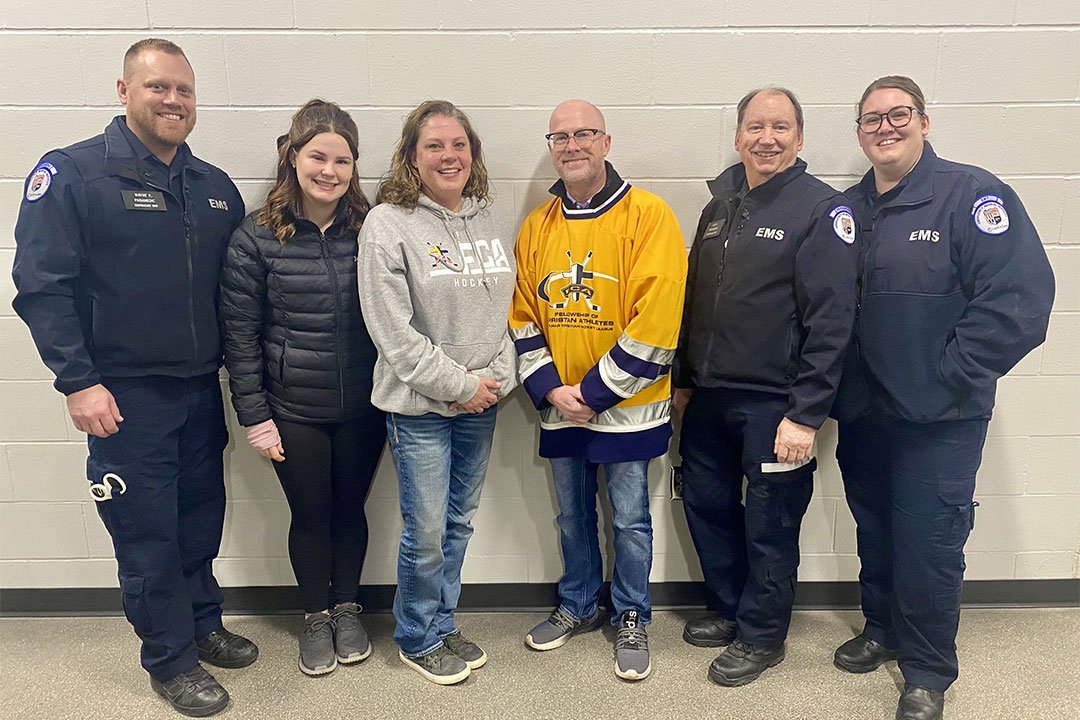 Fast action and skilled responsiveness of game bystander forever changed the life of an adult hockey player.
Fast action and skilled responsiveness of game bystander forever changed the life of an adult hockey player.
What began as a typical Sunday night adult hockey league game, quickly turned into a life and death situation for 54-year-old Tim Rehn of Willmar, Minn.
During the first period, without any warning signs or symptoms, Rehn collapsed to the ice at the hockey rink.
Attending the game that night was Heather Hubel-Coleman, whose husband, Jay, plays goalie for the men's hockey team.
"I had just picked up my daughter, Jaycie, from figure skating, and we decided to catch a few minutes of Tim's game while we were at the arena," said Hubel-Coleman. "We were preparing to leave for a planned trip to New York, so we stopped to wave goodbye. I am typically never at his games."
Hubel-Coleman and her daughter were watching the game from behind the glass at the end of the rink near the goalie's net.
"The minute Tim collapsed on the ice I heard someone yell for help," Hubel-Coleman recalls. "My husband turned and looked at me and pointed at me to go, and I just ran onto the ice."
Don't think, just act
As luck would have it, Hubel-Coleman is a former Emergency Medical Technician (EMT). She spent 16 years with Willmar Ambulance and four years with the Willmar Fire Department.
"You don't think, you just act," said Hubel-Coleman. "That's what I did for 20 years."
According to video footage taken at the arena to record the game, Hubel-Coleman arrived at Rehn's side within 19 seconds. When she reached him, Rehn still had a pulse.
"He had labored respirations, was gurgling, foaming at the mouth, and was turning blue," said Hubel-Coleman.
We took off his helmet and someone removed his ice skates.
Within seconds Hubel-Coleman noticed Rehn had stopped breathing and was in full cardiac arrest.
Rehn had been down for one minute and thirty seconds when Hubel-Coleman began her first chest compression.
"I lifted up his jersey and started doing compressions immediately," Hubel-Coleman said. "Someone from the other team called 911."
At the same time, Hubel-Coleman's 18-year-old daughter Jaycie knew to find the nearest AED, or automated external defibrillator.
 Heather Hubel-Coleman, Jaycie Coleman, and Tim Rehn pose with an AED at the Willmar Civic Center ice rink.
Heather Hubel-Coleman, Jaycie Coleman, and Tim Rehn pose with an AED at the Willmar Civic Center ice rink.
An AED is a sophisticated, yet easy-to-use, medical device that can analyze the heart's rhythm and, if necessary, deliver an electrical shock, or defibrillation, to help the heart re-establish an effective rhythm.
Because of Hubel-Coleman's experience as an EMT, she had instilled the importance of emergency preparedness in her daughter.
Jaycie, who is also certified in CPR and is a certified nursing assistant, knew where the AEDs were located at the arena from her time as a figure skater.
After quickly grabbing the AED, Jaycie handed it to a hockey player who took the patches off the paddles and handed it to Hubel-Coleman on the ice.
Following many compressions and a shock from the AED, Rehn took his first deep breath exactly four minutes and one second after he collapsed.
'I couldn't believe what happened.'
Meanwhile, Kandiyohi County received the 911 call and dispatched the Willmar Police Department to the Civic Center and requested an ambulance. Within five minutes the police arrived, with CentraCare EMS team members on the scene two minutes later.
When Paramedic, Wayne Rudningen and EMT, Emily Thompson, entered the rink, Rehn was alert and confused, but breathing on his own.
"We always prepare for the worst-case scenario when we receive a call," said Rudningen. "But we were completely surprised when we showed up, and he was alert and looked up at us and said 'hey.'"
"We have had cardiac arrest calls where the patient has been defibbed and they were alert before, but I've never seen someone whose heart rhythm and blood pressure were this good. He was totally alert and did not even believe he'd had a heart attack."
"I think he would have gotten back on the ice and played hockey if we would have let him," added Thompson.
Paramedic, Lyle Loge, was in his car when he heard the dispatch page, "Code 3 (emergent) for an unresponsive individual not breathing."
"When I arrived, the patient was being prepared to be taken off the ice with the assistance of Heather, ambulance personnel, and the peace officers," said Loge. "We were getting the cot and additional equipment ready off ice in the space between the bleachers."
After Rehn came to, his wife Pam, and Hubel-Coleman were on either side holding his hands.
"I could see my teammates looking at me with these looks of despair," remembered Rehn. "I couldn't understand what was going on. I felt perfectly fine."
Rehn recalls Hubel-Coleman telling him that he'd had a heart attack.
"I couldn't believe what happened," said Rehn.
Healing the heart
The EMS crew started an IV and transported Rehn to CentraCare – Rice Memorial Hospital for further stabilization before another ambulance transferred him to CentraCare Heart and Vascular Center in St. Cloud.
Several cardiologists cared for Rehn at CentraCare – St. Cloud Hospital. Tim Schuchard, MD, was the admitting physician, Brian Stegman, MD, performed the Percutaneous Coronary Intervention (PCI) in the cardiac catheterization Lab, and Stephen Kidd, MD, was the discharging cardiologist.
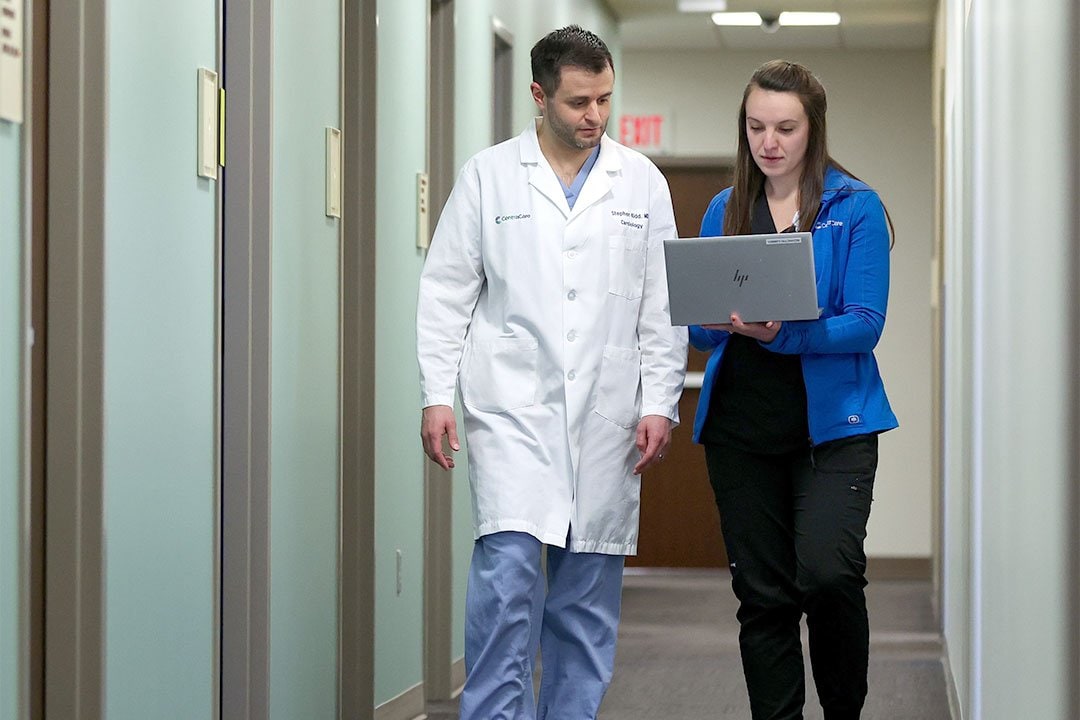 Cardiologist, Stephen Kidd, MD
Cardiologist, Stephen Kidd, MD
"He had stents placed during his initial procedure and was started on medications to help reset and recover his heart muscle," said Dr. Kidd. "He was discharged home with a temporary defibrillator that he wears around in case he has another arrhythmia while his heart is healing."
"I still couldn't believe it," said Rehn. "It took the doctor in the Cath lab to tell me about the blockage in my arteries — that was when I finally felt like this must have really happened to me."
Rehn had four stents placed in two arteries. He had 100% blockage in one artery and 90% blockage in a second.
Along with the temporary defibrillator vest he was sent home with, Rehn is attending cardiac rehabilitation and will have a follow up MRI to determine the amount of damage to his heart.
Don't be afraid to help
The Centers for Disease Control and Prevention estimate that 90% of people who experience cardiac arrest outside of a hospital die. Early CPR and bystander intervention can be the difference between life and death.
"I am so thankful to Heather, who not only knew what to do, but took the initiative to run down and help," said Rehn. "I don't think I'd be here today if it wasn't for her. I am forever grateful."
"Having rapid bystander CPR and access to defibrillation is one of the most important factors to a good prognosis after out-of-hospital cardiac arrest," explained Dr. Kidd.
"CPR continues to feed blood and oxygen to the brain and all vital organs while defibrillation will, hopefully, return the person to a normal heart rhythm thereby allowing the heart to circulate blood without the need for CPR. If this is not possible, continued CPR will support the vital organs around the heart until the heart can be fixed invasively by a procedure."
Hubel-Coleman stresses that people should not be afraid to help.
"Even if you don't know CPR, do something," said Hubel-Coleman. "I never gave Tim mouth-to-mouth; I only did chest compressions. You can't make it worse; he would have been dead if we did nothing. There are AEDs located all over the place. Don't be afraid."
Heart heroes
Hubel-Coleman's lightning-quick heroics didn't just catch the eye of Rehn's teammates; word of her brave act spread to the Minnesota Wild professional ice hockey team.
To show his thanks, Rehn wanted to surprise Hubel-Coleman and her family. He reached out to the Minnesota Wild to see about getting tickets to a game for them.
The Wild were impressed with the lifesaving account and asked Rehn to attend the Dec. 27 home game together with Hubel-Coleman and their families in a suite at the Xcel Energy Center.
"When we met each other at the game, the Wild surprised us with special jerseys. It was very cool," said Hubel-Coleman.
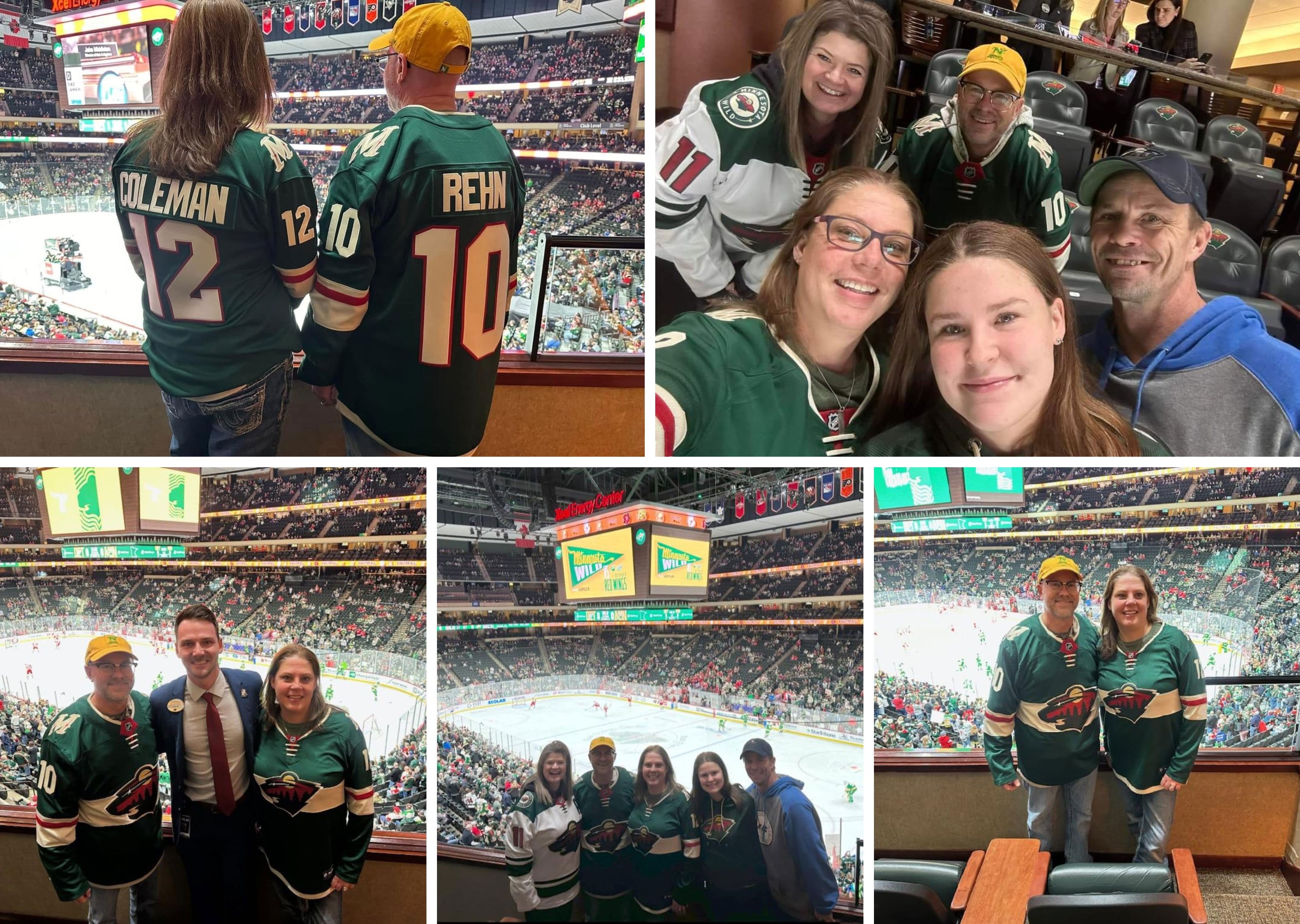 Rehn and Hubel-Coleman received Wild hockey jerseys with the numbers 12 and 10 respectively, to commemorate the life changing actions of December 10.
Rehn and Hubel-Coleman received Wild hockey jerseys with the numbers 12 and 10 respectively, to commemorate the life changing actions of December 10.
Hubel-Coleman posted on her Facebook page with a photo of their families together at the Wild game, "What an awesome night with our new friends that we met by chance."
Right place, right time, right reason
The month of February marks American Heart Month, a time when the nation shines a spotlight on heart disease, the No. 1 killer of Americans.
It was fitting then, that on February 13, during intermission of the Willmar Boys' High School home hockey game, Hubel-Coleman was recognized by the City of Willmar with a Citizen Life Saving Award for her actions.
 Willmar Police Captain, Mike Anderson, was reading through a report of events on Dec. 10, when he came across the details of the efforts at the Civic Center. Anderson connected with Willmar Parks and Rec Director, Rob Baumgarn, and discussed recognizing Hubel-Coleman with the award.
Willmar Police Captain, Mike Anderson, was reading through a report of events on Dec. 10, when he came across the details of the efforts at the Civic Center. Anderson connected with Willmar Parks and Rec Director, Rob Baumgarn, and discussed recognizing Hubel-Coleman with the award.
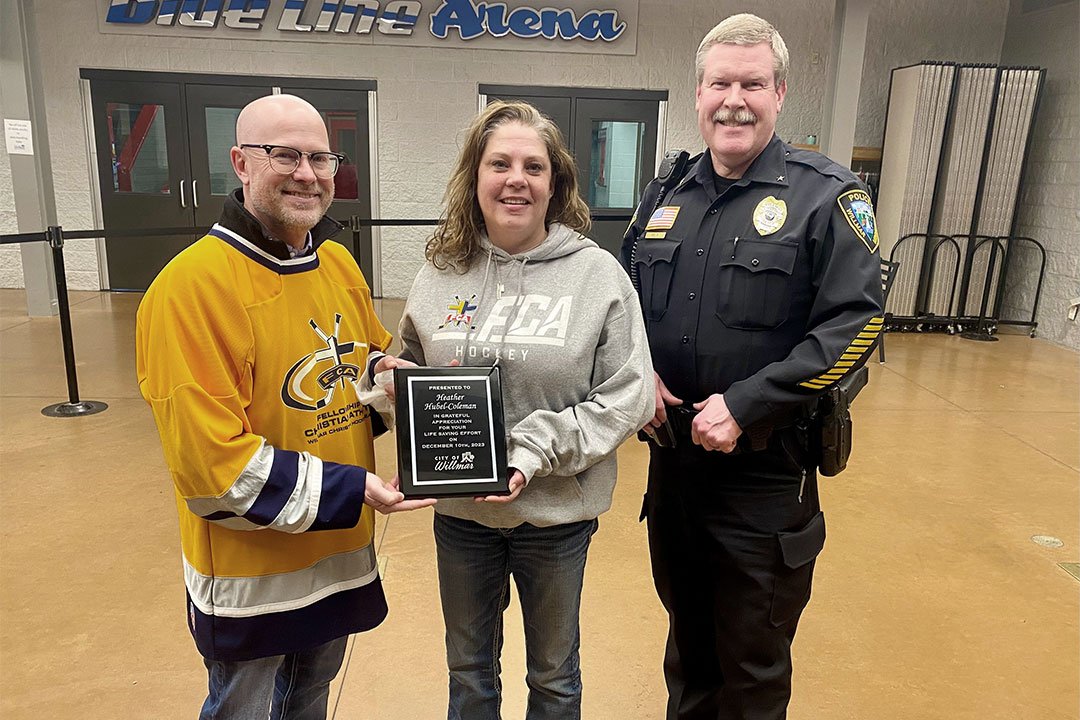 Rehn, Hubel-Coleman, and Police Chief, Jim Felt, with Heather's Life Saving Award on Feb. 13.
Rehn, Hubel-Coleman, and Police Chief, Jim Felt, with Heather's Life Saving Award on Feb. 13.
"We don't give this award out very often," said Willmar Police Chief, Jim Felt. "It's given to a citizen who has gone the extra mile and selflessly provided an effort that resulted in saving someone's life."
At the recognition event that evening, Rehn also had the opportunity to meet and thank the EMS team members and police officers that all played a role in his health journey on Dec. 10.
"There has been a lot of laughter and humor surrounding this event," said Rehn, "but it's really by the Grace of God that I'm still here. It has been a true miracle through and through and I am so thankful to everyone."
 Tim Rehn meets and thanks EMS team members Wayne Rudningen, Emily Thompson, and Lyle Loge.
Tim Rehn meets and thanks EMS team members Wayne Rudningen, Emily Thompson, and Lyle Loge.
"We're proud of all the team members who responded and were involved in the actions that day," said Felt. "Heather was in the right place at the right time for the right reason. And thankfully she was willing to step up to save a life."
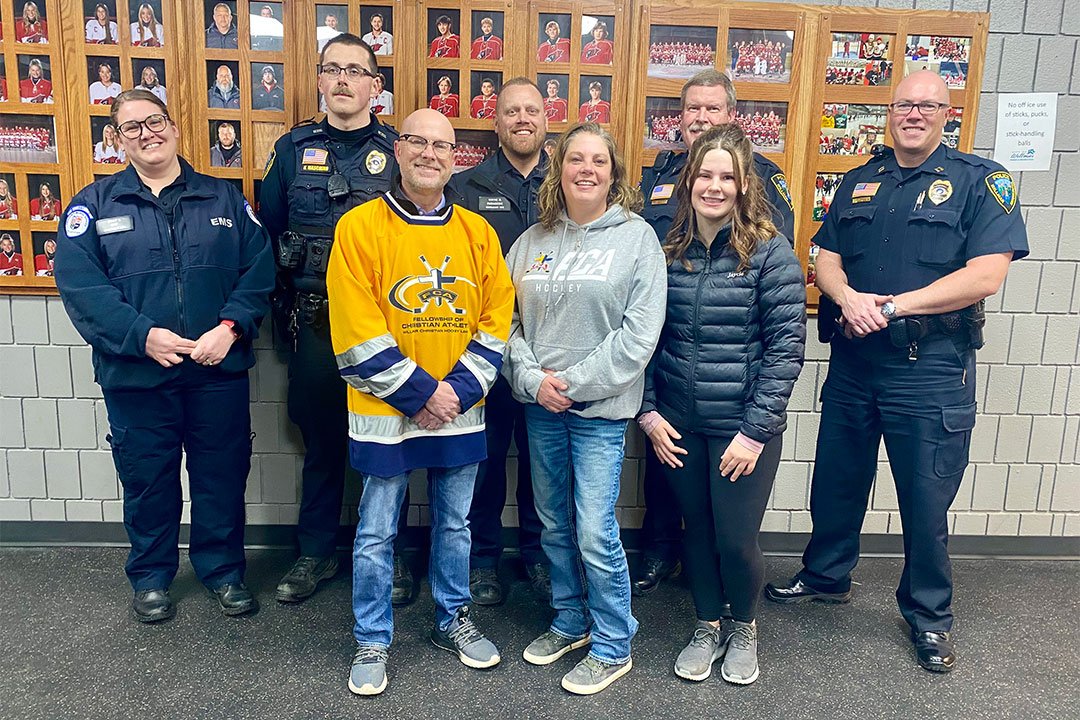 Predisposed to coronary disease
Predisposed to coronary disease
Rehn has always considered himself a healthy and active guy.
"I spend a lot of time running," said Rehn. "When it's nice outside I normally run at least four times a week from three to eight miles. I'm fortunate that the cardiac arrest didn't occur on one of those runs in the middle of nowhere."
Rehn could not recall having any symptoms or warning signs. "I could look back at being winded on occasion while playing hockey," said Rehn, "but I kind of attributed that to being an old guy trying to keep up with the young bucks."
"Despite a very active lifestyle and healthy appearance, Tim has a genetic predisposition to developing coronary disease," said Dr. Kidd. "This is why aggressive risk stratification and medical therapy in patients with risk and/or family history of coronary artery disease is essential."
Rehn shared that because of his family history it wasn't surprising to him that he would have a heart attack at some point but given the fact that he kept himself in fairly good shape he did not expect it so soon.
Dr. Kidd recommends if anyone has a history of heart disease, they should ask their physician team if a visit with a cardiologist is necessary.
"A simple lab test (LP(a)) or a coronary artery calcium score can help predict who will have heart issues in the future, even if they are healthy today," says Dr. Kidd.
"Don't wait until you have warning signs of a heart problem," Rehn stresses. "Be proactive. See your doctor and have your blood pressure and cholesterol checked."
Several of Rehn's friends who are around his age have since told him that they have scheduled doctor appointments to try and stay ahead of any potential heart problems.
Chance meeting, forever friends
Today, Rehn is doing well.
"I feel great," says Rehn. "I've always felt great. That is probably the hardest part of recovery and dealing with this. It is surreal to me. Everyone who was present that night, including my poor wife, had to witness a guy nearly die."
Following his heart attack Rehn was grappling with what came next.
"I was trying to figure out what my purpose was," said Rehn. "Why did this happen to me and why have I been given a second chance? The Lord decided to leave me on this Earth for some reason. I need to figure out what that is."
Recently Rehn believes he may have figured it out. He has set a goal to get AEDs into as many public places as possible. A project that had already started through the Willmar Rotary Club he belongs to.
"One new AED has been installed at Cash Wise grocery store, and one more is in the works to be installed at Robbins Island," explained Rehn.
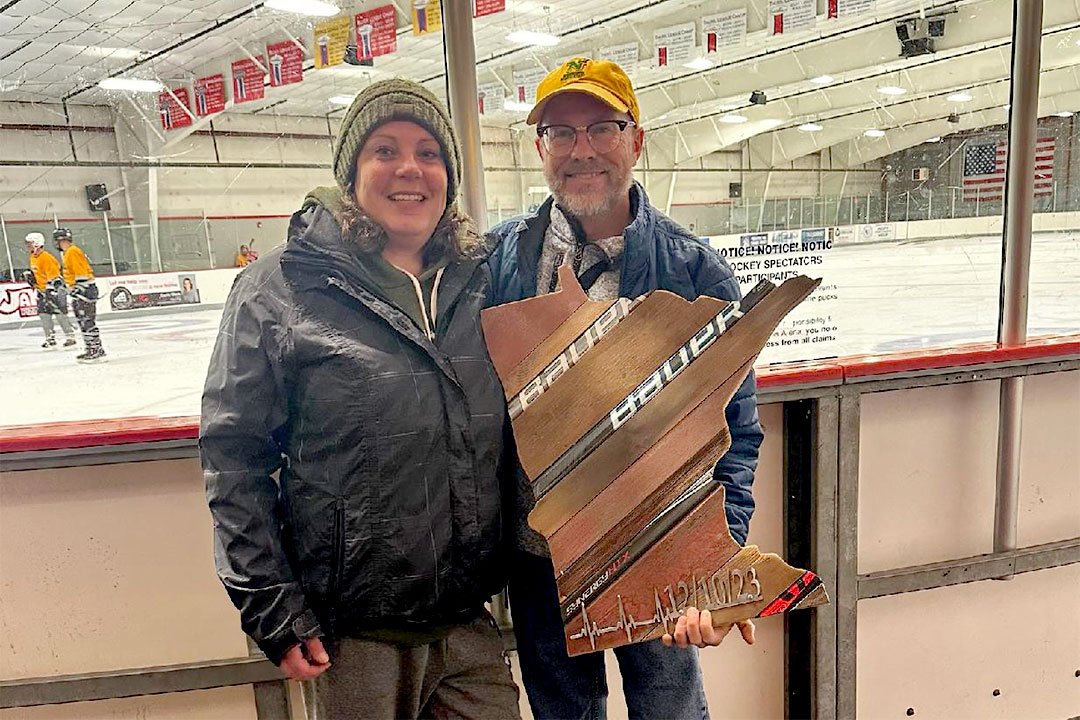 Hubel-Coleman with Rehn and a barn wood and hockey stick Minnesota sign she made for him with a metal heartbeat and date of the event.
Hubel-Coleman with Rehn and a barn wood and hockey stick Minnesota sign she made for him with a metal heartbeat and date of the event.
The Coleman and Rehn families have become close friends in the weeks following his cardiac arrest.
"My wife and I have met with Heather and her family multiple times," shared Rehn. "We now consider them part of OUR family."
Hubel-Coleman adds, "It happened for a reason. We are now the friends that we should have been forever.